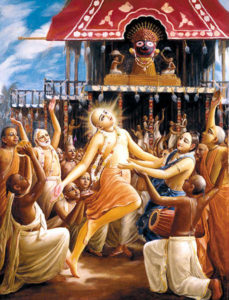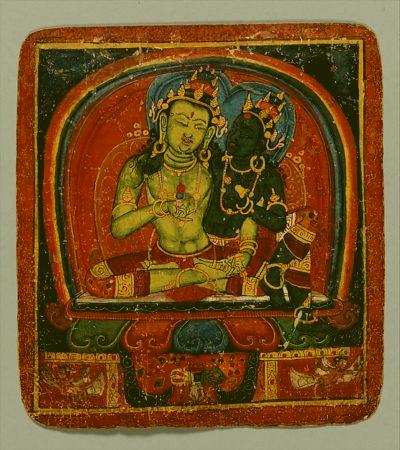The story goes that during 12th century in South India there lived a Brahmin by the name of Bilvamaṅgala Thakura who led an extremely debauched lifestyle and was very attracted to a prostitute named Cintamani. After the death of his father even before the period of mourning could get over, Bilvamaṅgala, his mind under the grip of instiable lust, walked through a storm, unknowingly using a dead floating corpse as a plank and a cobra as a rope to create a raft which he then used to cross the turbulent waters of a river to visit Cintamani’s residence on the other side of the river-bank. The prostitute was so disgusted by him that she remarked if he had applied a fraction of his attachment to Krshna he would became a saint. Struck by the caustic words, Bilvamaṅgala decided to leave his home and settle in Vrndavana. On the way he took shelter in a Brahmin’s house but even there he started lusting after the Brahmin’s wife. Once his mind calmed and he regained his sense, Bilvamaṅgala become extremely ashamed of his uncontrolled lust. He borrowed the hair-pin from the Brahmin’s wife and plucked out his own eyes, for, he thought if the eyes cannot see the world outside he would not be overcome by lust. A blind Bilvamaṅgala then reached Vrndavana where he took initiation from a Vaisnava Guru named Somagiri and composed songs on Radha and Krshna. Eventually his devotion become so single pointed that Krshna Himself would appear as a child to hold his hand and guide him around Vrndavana.
Bilvamaṅgala’s monastic name was Śrī-Līlā-Śuka – for he learnt to attain Śuka contemplating on the Lila of Sri Krshna. His most magnificient composition was called Śrī Kṛṣṇa-karṇāmṛtam meaning “necter for the ears of Śrī Kṛṣṇa”. The child Krshna would come and sit near him and listen to his songs and inspire him to compose more. Centuries later as Sri Chaitanya Mahaprabhu was touring India he found a manuscript of this text which he immediately asked his disciples to copy and carry along with them.

It is said when Chaitanya would enter into conditions of extreme bhava Samadhi, only the chanting of the karṇāmṛtam would bring his mind back to the normal state.
The text starts with a reference to Cintamani, without whose indirect prodding Bilvamaṅgala Thakura would not have realized Sri Krshna.
cintāmaṇir jayati somagirir gurur me
śikṣā-guruś ca bhagavān śikhi-piñcha-mauliḥ |
yat-pāda-kalpa-taru-pallava-śekhareṣu
līlā-svayaṁvara-rasaṁ labhate jaya-śrīḥ ||1||
(vasanta-tilaka)
All glories to Cintāmaṇi and my initiating spiritual master, Somagiri. All glories to my instructing spiritual master, the Supreme Personality of Godhead, who wears peacock feathers in His crown. Under the shade of His lotus feet, which are like desire trees, Jayaśrī (Rādhārāṇī) enjoys the transcendental mellow of an eternal consort.
mukulāyamāna-nayanāmbujaṁ vibho
muralī-nināda-makaranda-nirbharam |
mukurāyamāṇa-mṛdu-gaṇḍa-maṇḍalaṁ
mukha-paṅkajaṁ manasi me vijṛmbhatām ||6||
(mañju-bhāṣiṇī)
May the lotus of my Lord’s face blossom within [the lake of] my mind. The eyes of that face resemble lotus buds, being half-closed, and the delicate mirror-like orbs of its cheeks are puffed with the nectarine honey of the flute-sound.
Paintings depict Līlā-Śuka singing to Lord Krshna.


